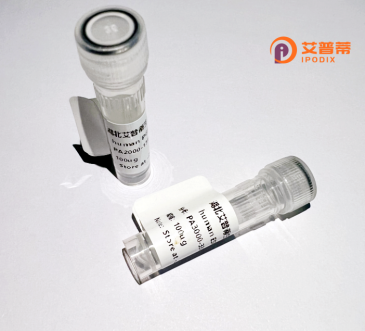
| 纯度 | >90%SDS-PAGE. |
| 种属 | Human |
| 靶点 | TMPRSS13 |
| Uniprot No | Q9BYE2 |
| 内毒素 | < 0.01EU/μg |
| 表达宿主 | E.coli |
| 表达区间 | 187-586 aa |
| 活性数据 | QFWQGHTGIRYKEQRESCPKHAVRCDGVVDCKLKSDELGCVRFDWDKSLLKIYSGSSHQWLPICSSNWNDSYSEKTCQQLGFESAHRTTEVAHRDFANSFSILRYNSTIQESLHRSECPSQRYISLQCSHCGLRAMTGRIVGGALASDSKWPWQVSLHFGTTHICGGTLIDAQWVLTAAHCFFVTREKVLEGWKVYAGTSNLHQLPEAASIAEIIINSNYTDEEDDYDIALMRLSKPLTLSAHIHPACLPMHGQTFSLNETCWITGFGKTRETDDKTSPFLREVQVNLIDFKKCNDYLVYDSYLTPRMMCAGDLRGGRDSCQGDSGGPLVCEQNNRWYLAGVTSWGTGCGQRNKPGVYTKVTEVLPWIYSKMEVRSLQQDTAPSRLGTSSGGDPGGAPRL |
| 分子量 | 51.7 kDa |
| 蛋白标签 | GST-tag at N-terminal |
| 缓冲液 | PBS, pH7.4, containing 0.01% SKL, 1mM DTT, 5% Trehalose and Proclin300. |
| 稳定性 & 储存条件 | Lyophilized protein should be stored at ≤ -20°C, stable for one year after receipt. Reconstituted protein solution can be stored at 2-8°C for 2-7 days. Aliquots of reconstituted samples are stable at ≤ -20°C for 3 months. |
| 复溶 | Always centrifuge tubes before opening.Do not mix by vortex or pipetting. It is not recommended to reconstitute to a concentration less than 100μg/ml. Dissolve the lyophilized protein in distilled water. Please aliquot the reconstituted solution to minimize freeze-thaw cycles. |
以下是关于重组人TMPRSS13蛋白的3篇参考文献概览:
1. **文献名称**:*TMPRSS13 is a novel plasminogen receptor promoting cell surface proteolytic activity*
**作者**:Bachman H. et al.
**摘要**:该研究鉴定了TMPRSS13作为新型纤溶酶原受体,发现其通过调控细胞表面蛋白水解活性参与细胞迁移和组织重塑,并利用重组蛋白证实其与纤溶酶原的结合能力及功能关联。
2. **文献名称**:*Role of TMPRSS13 in iron homeostasis and hepcidin regulation*
**作者**:Silvestri L. et al.
**摘要**:研究发现TMPRSS13通过切割膜铁转运蛋白(hepcidin)调控铁代谢,利用重组人TMPRSS13蛋白验证其酶活性,揭示其突变可能导致遗传性铁过载疾病的潜在机制。
3. **文献名称**:*Structural characterization of recombinant TMPRSS13 protease and its inhibition by synthetic peptides*
**作者**:Grys M. et al.
**摘要**:通过重组表达获得TMPRSS13胞外域蛋白,解析其三维结构并筛选抑制肽,为开发针对该蛋白酶相关疾病(如癌症转移)的抑制剂提供结构基础。
如需获取具体文献,建议通过PubMed或Sci-Hub输入标题或DOI查询全文。
TMPRSS13. also known as Transmembrane Serine Protease 13 or Motile Sperm Domain-Containing Protein 1 (MOSPD1), is a member of the type II transmembrane serine protease (TTSP) family. These proteases are characterized by a transmembrane domain, a cytoplasmic tail, and an extracellular serine protease domain. TMPRSS13 is primarily expressed in epithelial tissues, including the respiratory and gastrointestinal tracts, and plays roles in proteolytic processing of various substrates, such as extracellular matrix proteins, growth factors, and viral envelope glycoproteins. It shares structural homology with other TTSPs like TMPRSS2. which is implicated in viral entry (e.g., SARS-CoV-2 activation).
Functionally, TMPRSS13 is involved in tissue homeostasis, immune response modulation, and cellular signaling. Studies suggest its participation in epithelial barrier maintenance and inflammatory regulation through protease-activated receptor (PAR) pathways. Additionally, it may facilitate viral pathogenesis by cleaving viral surface proteins to enhance host cell entry. Genetic variants of TMPRSS13 have been linked to diseases, including cancer and inflammatory conditions, though its precise mechanisms remain under investigation. Recent interest in TMPRSS13 has grown due to its potential therapeutic or diagnostic relevance in viral infections and epithelial disorders. However, further research is needed to fully elucidate its physiological and pathological roles.
×